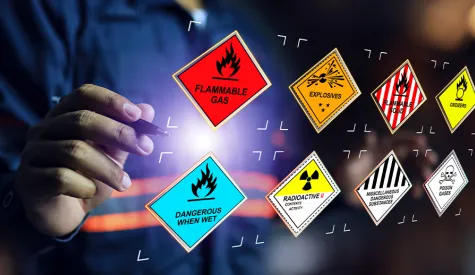Rules for Proper Secondary Container Labeling

When transferring a chemical from its original container to another, the second storage device is known as a "secondary container," "portable container," or "workplace container." Transferring chemicals from one container to another is expected, so the Occupational Safety & Health Administration (OSHA) has included the required information for proper secondary container labels as part of the Hazard Communication Standard (HCS). This standard ensures workers are aware of the chemicals involved in potential exposure.
There have been numerous recent incidents of worker injury, including fume inhalation and fires on cargo ships, that can be traced back to missing secondary labels. A few of the common problems that cause these type of incidents include:
- Hazardous products not being used within the same work shift as the person who made the transfer from the primary to a secondary container of the hazardous chemical.
- The person who oversaw the transfer left the work area.
- The secondary container itself leaves the work area incorrectly identified.
The most recent revision of the Hazard Communication System aligns U.S. hazardous chemical labeling standards with those of the international GHS labels (Globally Harmonized System of Labeling and Classifications), making it easier for everyone to understand the hazards related to chemicals nationally and internationally. Though hazardous chemical label requirements dictated by GHS have been made clear, many are still confused about how and if requirements for secondary container labels have changed and, if so, what those requirements are.
Compliance with the Globally Harmonized System (GHS) is about more than authoring SDSs (Safety Data Sheets) and ensuring your staff knows how to read them. It also includes an essential component ensuring safety data is available throughout your facility on any secondary chemical containers used to store hazardous material.
Benefits of Proper Labeling
Container labeling not only provides essential safety information, but also allows companies to track accurately all the hazardous products and chemicals they have. This labeling becomes valuable not only for regulatory compliance purposes but is also advantageous for companies interested in tracking chemical life cycles. A barcode or a specific classification number on the label creates an understanding of how a material enters a facility, is used, and leaves as waste. This is incredibly valuable for giving companies visibility into their hazardous material handling processes from beginning to end.
Secondary Container Label Requirements
Employers must make sure each container of hazardous chemicals in the workplace is labeled, tagged, or marked with either of the following:
- All the specific information for the labels on shipped containers.
- The hazard identification and words, pictures, symbols, or a combination provide at least general information about the physical hazards of the chemicals.
Generally, these are the types of items that must include container labels:
- Storage bottles were created for the distribution of small amounts of material.
- Storage bottles used for solutions or dilutions of a chemical.
- Spray bottles for solutions or dilutions of a chemical
- Sample vials or sealable tubes. Large batches of the same compound may be labeled collectively, provided they are stored and handled as a group.
Exceptions
Only a few exceptions apply to secondary container labels. These include:
- If the container size is impractical to house a label.
- If the chemicals are produced in a workplace but are not for sale.
- Products meant for immediate use. Immediate use means the hazardous chemical will be controlled and used only by the person who transfers it from a labeled container to a secondary container.
In all the above cases, management is responsible for creating an alternative system which provides the same information on the original GHS-compliant label in a different written or displayed format. For example, a process sheet, placard, or other written material that includes the details can be displayed in the workplace.
Because secondary container labeling rules are essential to the safety of the workforce, enforcement institutions take them very seriously. So be sure to educate all employees and supervisors on good practices.


